

Document 1192. 2008–10 Thai political crisis. The People's Alliance for Democracy laid siege to and occupied the Government House from August to December of 2008.

History[edit] The PPP won the December 2007 general election. Though it became the largest party in the House, it did not gain an absolute majority. However, PPP became the leading party when five other smaller parties, who had previously been allies of Thaksin Shinawatra, agreed to join the coalition government under Samak Sundaravej. List of wars 2011–present. List of wars 2003–2010. Note: War is a state of opened and declared armed hostile conflict between states or nations.[1] For other conflicts, see rebellions, coups and separate battles.

This is a list of wars launched from 2003 to 2010. Other wars can be found in the historical lists of wars and the list of wars extended by diplomatic irregularity. List of wars 1990–2002. Korean War. The Korean War (25 June 1950 – 27 July 1953)[29][a][31] was a war between the Republic of Korea (South Korea), supported by the United Nations, and the Democratic People's Republic of Korea (North Korea), at one time supported by China and the Soviet Union.

It was primarily the result of the political division of Korea by an agreement of the victorious Allies at the conclusion of the Pacific War at the end of World War II. The Korean Peninsula was ruled by the Empire of Japan from 1910 until the end of World War II. Following the surrender of the Empire of Japan in September 1945, American administrators divided the peninsula along the 38th parallel, with U.S. military forces occupying the southern half and Soviet military forces occupying the northern half.[32] The failure to hold free elections throughout the Korean Peninsula in 1948 deepened the division between the two sides; the North established a communist government, while the South established a right-wing government. List of proxy wars. Bandung Revisited: The Legacy of the 1955 Asian-African Conference for ... - Amitav Acharya - Google หนังสือ.
The Lessons of the Bandung Conference. Reviewing Richard Wright's The Color Curtain 40 Years Later by Matthew Quest "The despised, the insulted, the hurt, the dispossessed—in short, the underdogs of the human race were meeting.
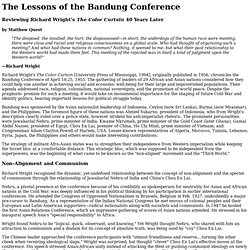
The Asian-African Conference. Bandung Revisited: The Legacy of the 1955 Asian-African Conference for ... - Amitav Acharya - Google หนังสือ. Www.ohioswallow.com/extras/9780896802773_chapter_1.pdf. จาก 9/11 ถึงสงครามอิรัก « Midnight University. Cold War. Photograph of the Berlin Wall taken from the West side.

The Wall was built in 1961 to prevent East Germans from fleeing Communism and to stop an economically disastrous drain of workers. It was an iconic symbol of the Cold War and its fall in 1989 marked the approaching end of the War. The Cold War was a sustained state of political and military tension between powers in the Western Bloc (the United States with NATO and others) and powers in the Eastern Bloc (the Soviet Union and its allies in Warsaw Pact). Historians have not fully agreed on the dates, but 1947–1991 is common. It was "cold" because there was no large-scale fighting directly between the two sides, although there were major regional wars in Korea and Vietnam.
ความขัดแย้งในภูมิภาคต่างๆหลังสงครามเย็น. สงครามเย็น. Www.bandung2.co.uk/books/Files/Politics/The Rise and Fall of Afro-Asian Solidarity - Guy J. Pauker.pdf. Untitled Document. บทบาทของรัสเซียในเอเชียตะวันออกและโอกาสสำหรับประเทศไทย. สารคดี สงครามเย็น 1/3. Nikita Khrushchev. Office of the Historian - Milestones - 1953-1960 - U.S.-China Ambassadorial Talks. U.S.

-China Ambassadorial Talks, 1955–1970 On August 1, 1955, the United States and the People’s Republic of China (PRC) opened a series of ambassadorial-level talks in Geneva to discuss the repatriation of nationals and other issues of mutual concern. Because the two countries did not have formal diplomatic relations, the talks were the principle form of contact between them for sixteen years. The Chinese proposed the negotiations because Sino-American tensions were high, causing concern to bystanders throughout the region. Franke.uchicago.edu/Final_Communique_Bandung_1955.pdf. Cold War. 1947–1991 period of geopolitical tension between the Eastern and Western Bloc Borders of NATO (blue) and Warsaw Pact (red) states during the Cold War-era in the Northern Hemisphere.
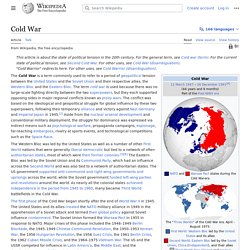
With her brother on her back, a Korean girl trudges by a stalled American M46 Patton tank, at Haengju, South Korea, 1951 The Cold War and its events have left a significant legacy. It is often referred to in popular culture, especially with themes of espionage and the threat of nuclear warfare. Meanwhile, a renewed state of tension between the Soviet Union's successor state, Russia, and the United States in the 21st century (including its Western allies) as well as growing tension between an increasingly powerful China and the U.S. and its Western allies have each been referred to as the Second Cold War.
Asian–African Conference. A snapshot during the first Conference in 1955 The building in 2007; now it is a museum of the conference The first large-scale Asian–African or Afro–Asian Conference—also known as the Bandung Conference (Indonesian: Konferensi Asia-Afrika) —was a meeting of Asian and African states, most of which were newly independent, which took place on April 18–24, 1955 in Bandung, Indonesia.
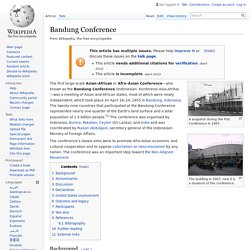
The twenty-nine countries that participated at the Bandung Conference represented nearly one-quarter of the Earth's land surface and a total population of 1.5 billion people.[1] The conference was organised by Indonesia, Burma, Pakistan, Ceylon (Sri Lanka), and India and was coordinated by Ruslan Abdulgani, secretary general of the Indonesian Ministry of Foreign Affairs. Dag Hammarskjöld – biography. Dag Hammarskjöld (1905–1961) was the UN Secretary-General 1953–1961.
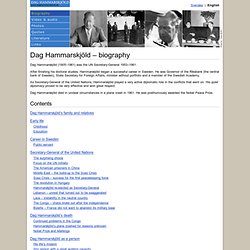
After finishing his doctoral studies, Hammarskjöld began a successful career in Sweden. He was Governor of the Riksbank (the central bank of Sweden), State Secretary for Foreign Affairs, minister without portfolio and a member of the Swedish Academy. As Secretary-General of the United Nations, Hammarskjöld played a very active diplomatic role in the conflicts that went on. His quiet diplomacy proved to be very effective and won great respect. Www.dhf.uu.se/pdffiler/cc2_web.pdf. Dag Hammarskjöld. Dag Hjalmar Agne Carl Hammarskjöld (Swedish: [dɑːɡ ˈhamːarɧœld] ( ); 29 July 1905 – 18 September 1961) was a Swedish diplomat, economist, and author.
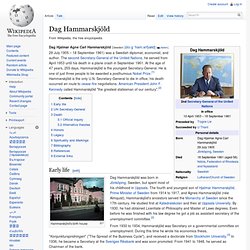
The second Secretary-General of the United Nations, he served from April 1953 until his death in a plane crash in September 1961. At the age of 700147000000000000047 years, 7002255000000000000255 days, Hammarskjöld is the youngest Secretary-General. He is one of just three people to be awarded a posthumous Nobel Prize.[1] Hammarskjöld is the only U.N. Munich massacre. The attackers were apparently given logistical assistance by German neo-Nazis.[10] Five of the eight members of Black September were killed by police officers during a failed rescue attempt. The three surviving attackers were captured, but later released by West Germany following the hijacking of a Lufthansa airliner. Israel responded to the killers' release with Operation "Spring of Youth" and Operation "Wrath of God", during which Israeli intelligence agency Mossad and special forces systematically tracked down and killed Palestinians suspected of involvement in the massacre.
Prelude[edit] Suez Crisis. The Suez Crisis, also referred to as the Tripartite Aggression, Suez Canal Crisis, Suez War, or Second Arab-Israeli War[13][14] (Arabic: أزمة السويس / العدوان الثلاثي Azmat al-Suways / al-ʻUdwān al-Thulāthī , "Suez Crisis"/ "the Tripartite Aggression"; French: Crise du canal de Suez; Hebrew: מבצע קדש Mivtza' Kadesh "Operation Kadesh," or מלחמת סיני Milẖemet Sinai, "Sinai War"), was a diplomatic and military confrontation in late 1956 between Egypt on one side, and Britain, France and Israel on the other, with the United States, the Soviet Union, and the United Nations playing major roles in forcing Britain, France and Israel to withdraw.[15] Less than a day after Israel invaded Egypt, Britain and France issued a joint ultimatum to Egypt and Israel, and then began to bomb Cairo.
Background. Radicalism (historical) The American Revolutionary War ended in humiliating defeat of a policy which King George III had fervently advocated, and in March 1782 the King was forced to appoint an administration led by his opponents which sought to curb Royal patronage. In November 1783 he took his opportunity and used his influence in the House of Lords to defeat a Bill to reform the British East India Company, dismissed the government and appointed William Pitt the Younger as his Prime Minister.
Pitt had previously called for Parliament to begin to reform itself, but he did not press for long for reforms the King did not like. Proposals Pitt made in April 1785 to redistribute seats from the "rotten boroughs" to London and the counties were defeated in the House of Commons by 248 votes to 174.